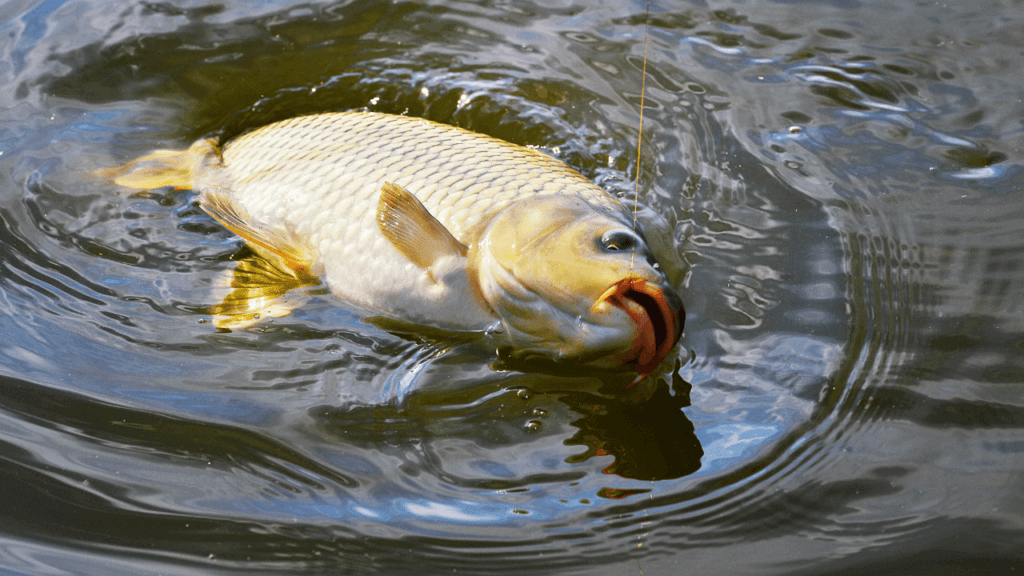Learning how to catch carp is a fun and exciting challenge for anyone who likes to spend a day out on the water.
Once considered dumb ugly bread eaters, these fish are now known to be a strong fighting intelligent species. There is even a growing carp tournament scene here in the US.
Unlike the popular largemouth bass, huge carp can be found in almost every state and they are actually excellent table fish.
So with all these monster fish swimming around right under your nose, wouldn’t you like to give carp fishing a go?
Below, I’m sharing our top tips, tricks, and know-how about catching carp so you can impress even the most experienced carp anglers.
Carp Basics
The first step to any successful day fishing is understanding your prey.
Carp are native to both Asia and Europe, and they were brought into the US back in the 1800s.
They are bottom feeders, the largest in the minnow family related to the small goldfish, that can thrive in a realm of different conditions. They’re freshwater fish and are commonly found in areas like lakes, ponds, and rivers.
Carp have round, long bodies with a long and short dorsal fin, barbels around their mouth, and a pronged tail. Their color varies but typically falls somewhere between bright gold to dark green.
The average carp weighs about 10-15 pounds and is ~30 inches in length. But some monster carp are much larger than this, reaching up to 30 pounds and sometimes even as high as 60 pounds.
Carp are available to fish all year round. But some areas prohibit fishing during spawning season. This is usually during late spring or early summer when waters reach a steady range.
Traits and Characteristics
Carp have scales that cover the fish’s body with a goldish-greenish hue. There are two primary variants of carp known as the leather carp or the mirror carp.
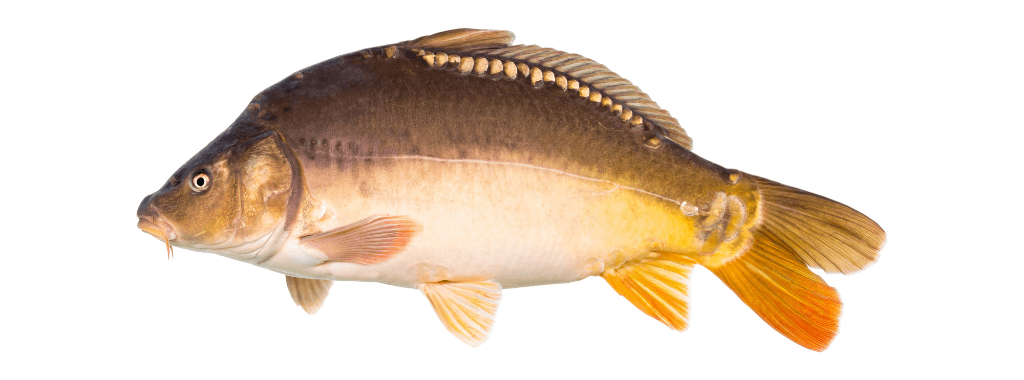
Leather carp have fewer scales, with just a few near their dorsal fin. This makes them look slick and leathery, as their name suggests.
Mirror carp have scales are that are large and shiny, reminiscent of a mirror.
These fish are omnivores. They feed on vegetation such as cattails, grass, and leaves. They also like prey such as crawfish, minnows, beetles, grasshoppers, and aquatic insects.
Using powerful “pharyngeal teeth” in the back of their throats, carp can crush and eat many foods that other fish can’t. They’re known to eat just about anything and are a true opportunistic omnivorous feeder.
Carp tend to be quite repetitious. Once they take a liking to a certain food, they will seek it out and often ignore other foods. A bit like trout that are feasting on a certain bug hatch
Their habitual food choices are something anglers can use to their advantage…especially if they chum for carp….but more on that later.
Finding Carp
Now that you know a bit more about your prey, let’s learn a little about where you can find carp.
While they can survive (and thrive) in just about any area, carp have preferences making it easier to pinpoint and catch them. They prefer to spend time in large rivers, lakes, and reservoirs where the water moves slowly.
But, you can find surprising populations of these fish in ponds, canals, and even ditches. If you’re an urban angler, this is good news, as you don’t need to go very far.
Fishing in a River
If you’re planning to fish for carp alongside a river, there are a few things you should know.
You need to understand the current and what that current means for the fish.
For fish to fight against the river’s flow, they use much more energy than they would in a lake. They have to eat often to keep their energy up, so they tend to stick around areas where they know there will be food.
In rivers carp will often seek to avoid the current so you can find them relaxing in pools and eddies.
Another commonplace to find them along the river is where two bodies of water connect. This usually creates an area of deposited food for them to feed on.
Fishing in a Lake
Fishing in a lake can be easier than in a river.
In lakes, you can find carp in transition areas where the depth quickly moves from deep to shallow. Carp will move into the shallows to feed but then hurry back to the depths to hide. They also tend to like areas with a bit of shelter and structure, like logs, branches, or weeds.
Head to these places, cast a line, keep it still, and wait. Make sure you have a sinker on your line to keep your bait near the bottom of the lake where carp usually hang out.
How to Catch Carp – Tips & Tricks
From getting set up with the best big carp tackle to being patient and waiting for that first bite. Here’s what you should keep in mind when thinking about how to catch carp.
Have the Right Equipment
First thing’s first, make sure you have the right equipment. That means rod, reel, hooks, line and, carp bait. Everything you would expect to have as part of your tackle.
Rod
As carp are not usually small fish you need to ensure you have the right rod to handle their extra weight.
The best carp fishing rod is a 12-foot rod with a 2.75-pound test curve and a medium action.
Carp fishing rods are usually 12′ to 13′ in length. Longer rods give you the ability to cast further. This is especially beneficial when bank fishing.
If you’re new to carp angling and are using 12′ to 13′ rods for the first time, be sure to do some practice casts. It is completely different than using a 6′ to 8′ rod that many anglers use to target other popular sport fish.
A medium action rod is good for casting distance and precise fishing. It is a versatile rod and you can’t go wrong with it.
Another important part of the rod is the handle length. Because when carp angling you often need to cast a long distance. This requires you to two hands to cast. Using a fishing rod with a shorter handle you will struggle to do this. Choose rods that have a “fighting butt”. These provide balance and grip and allow you to get two hands on your rod to ensure you to get the best distance with your cast.
Reel
The best carp reel will allow you to cast to the distance you need, retrieve the line quickly, and give you enough power and control to net a fish.
Conventional fishing reels are designed for repeatedly casting short distances.
Carp fishing differs as anglers seek longer distances and make fewer casts.
Select a reel with a high retrieval rate of 5.1:1 or more. Carp are capable of quickly swimming towards you. When they do, with a slow retrieval rate, you will get a slack line and lose the fish.
Larger spools are better when it comes to carp fishing. There are two main reasons:
Firstly, because you need to cast longer distances you need more line capacity. Secondly, and importantly carp will run long distances so you need to ensure you have enough line for the fight.
If you want to target monster carp then a Big Pit Reel is the way to go. Big Pit Reels have very large spools and are heavily geared.
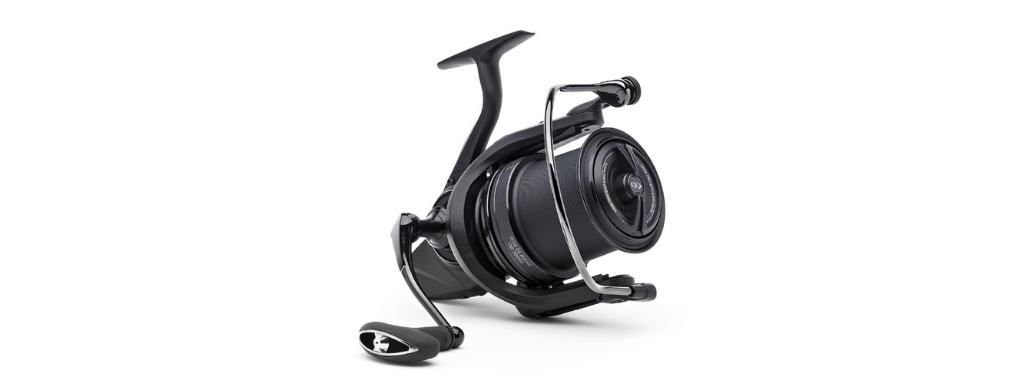
These reels allow carp anglers to target big carp at long range with ease. They allow for greater casting distance and greater accuracy. Which is ideal for large bodies of water.
Big Pit Reels are on the top of most carp anglers’ wish lists. The only downside is their extra size, weight, and price tag.
Two excellent examples of Big Pit Carp Fishing Reels are the Daiwa 19EM45SCW-QD and the Daiwa 20 Emblem 45 SCW QD OT. Both these reels are big and grunty and specifically designed to catch big carp. A must have as part of any carp tackle setup and when you are planning how to catch carp.
Hooks
Carp are big fish with small mouths so it’s easy to overestimate the hook size you’ll need.
I find that #6 to #10 size hooks work well, with the smaller sizes reserved for warier fish.
A large part of catching a lot of carp is to do with bait presentation. You want to avoid shiny hooks, which carp can pick up on with their great eyesight. Instead, use a dark or even camouflage hook to catch them by surprise.
Circular hooks work well although they tend to work best when bottom fishing.
Securing and presenting the bait is important. Hooks with barbs on the shank can be helpful to secure some baits. To make a bait look as natural as possible finer wired hooks are a good choice for your big carp tackle box.
Line
As a general rule of thumb, fish with the thickest line that can be cast the distance you’re targeting.
Monofilament is a great choice as a carp fishing line. As long as you choose the right diameter, it’s strong enough to absorb the lunges of even the most powerful monster carp.
You want to use at least a line strength of 15 lbs but you can go right up to 50 lbs, in your big carp tackle setup, if you’re targeting those bigger trophy fish.
Likewise, I would only consider braid if I was serious about trying to bag a monster carp.
Bait
For carp fishing, you can leave your lures at home.
The best bait for carp is usually boilies since the scent of the fishmeal attracts carp pretty strongly. Although some carp begin to associate these boilies with danger, and they may avoid them.
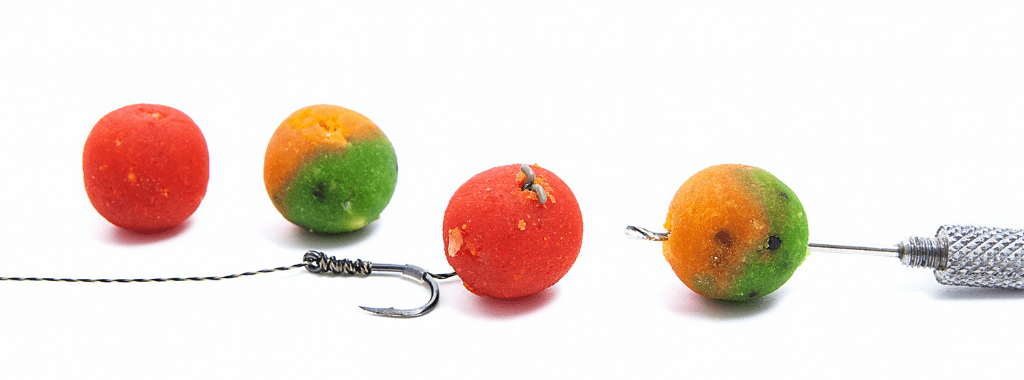
Another good bait option, to have in your tackle, is canned sweet corn. While this might surprise you, but the combination of sweet and salty corn is irresistible for carp. It’s also cheap and easy to access, making it the perfect thing to pick up on your way to the water.
There are many baits you can use to catch carp, and the theme here should be simplicity. There’s no need to make things more complicated than necessary.
A great way to get started is to simply throw in a bit of bait you are planning to use into the area. This is known as chumming the water to test the response in the area.
If fish rush to the surface for a floating pellet or crust piece, try tossing them some more freebies to make them more relaxed before casting your line.
Another common method is to use a dissolvable or mesh PVA bag filled with chum attached to the rig and in the water.
One important point to note about bait and chumming is that every state has laws that regulate the type of bait allowed. So make sure you check and understand the rules for the area you are fishing before adding chum to your big carp tackle kit.
Rigging for Carp Fishing
The most common and basic rig for carp fishing is the hair rig. It was approved as IGFA-compliant in 2007 and specifically targets and takes advantage of the way carp feed.
Carp feed by sucking any prey into their mouth to inspect, before spitting it all out. They rarely eat your bait on first inspection. So this inspection process can happen many times before a decision is made to eat your bait.
Carp have many taste sensing cells/sensors in and around their mouth area. Using these sensors cells is how a carp inspects potential food items.
With the hair rig when the carp sucks in the bait, it will suck in the hook also. Then when blowing it out as the bait exits the mouth the hook pierces the bottom lip of the fish and it is caught.
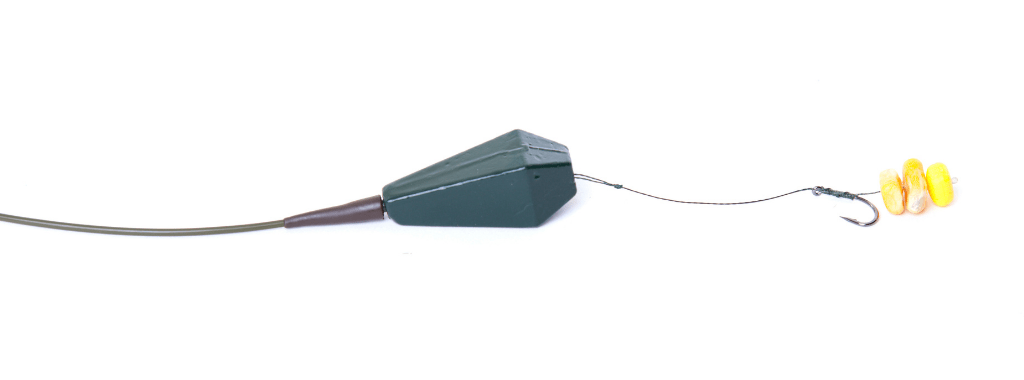
I recommend using the hair rig when fishing a clear bottom like flat rock or sand. This is because the rig is meant to lay flat on the bottom and the hook needs to be free of obstructions such as weeds and sticks on which it could easily snag.
Plus, gravel and silt can cause the hook to become lodged into the bottom, causing a dull or buried hook and, thus a reduced chance of a successful catch.
Fishing over a solid bottom is ideal for this classic rig and it is a proven carp catcher in these conditions. So be sure to include it in your tackle box.
Go at the Right Time
You can catch carp any time of year. If you’re planning to go fishing in the winter, you might want to consider going at night to gain the benefit of the cover of darkness. At night, carp often patrol the margins of the lake or river where they are, searching for bait leftover from daytime anglers.
Plus, the extra darkness will make it harder for the carp to notice a line or hook, which could work in your favor.
If you fish in the summer or spring, you’ll find that the fish swim faster and have more energy. They’re more active, which means they need to feed more. Dawn and dusk are always great times of day to show up.
Go to the Right Place
Carp favor areas that have soft, muddy bottoms where they can swim and feed. They are resistant to areas with high pollution or low oxygen, but they can still make it work, as seen in city lakes and ponds.
While they prefer slower waters, they are incredibly adaptable and can become more muscular to swim against currents. They also prefer warmer water. So finding areas in the sun that still have some support or structure to them can be a hotbed for carp.
Identify Feeding Spots
Some of the signs to look for to identify a feeding spot include:
● Warm water – While they like to stay at the bottom, they also prefer warmer water, which is usually near the top. Look for areas that receive a lot of sunlight, as they’ll retain more warmth than shaded regions.
● Cloudy water – Cloudy water provides excellent coverage and keeps carp safe – or so they think. Areas with mud or sediment can also cloud the water, making it a great spot for carp to feed safely.
● Vegetation – Any areas with overgrown weeds, broken tree branches, logs, excessive leaves, or coverage of any kind are popular with carp.
Keep Still
One of the most important parts of carp fishing is staying still once your line is cast. They will notice even small movements, like the jiggling of a line, and they won’t bite.
If you want to find success angling for carp on the water, you’ll need to keep incredibly still.
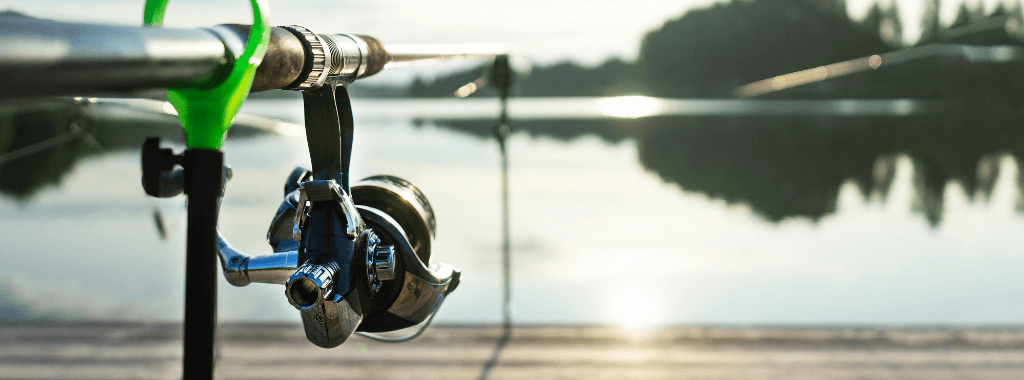
Using a rod pod, as part of your big carp tackle, is the perfect tool to keep it steady and strong enough to resist even a serious carp bite.
Watch Your Hands
Watch your hands when you’re adding the carp bait to the end of your line. If you touch the bait too much, the fish will pick up on these smells, and they’ll swim away because they’ll know there’s an angler up there somewhere.
You want it to smell as natural as possible, so use gloves if needed to avoid contamination with your scent.
Be Prepared for a Fight
Carp are known to be strong and resistant fighters, so you should always be prepared for a bit of a fight when reeling them in. Make sure your rod is flexible but sturdy, and have a friend nearby if you need more help.
A strong carp has the potential to pull a small kayak, so you don’t want to waste any time pulling them in once they bite.
Final Thoughts
Carp are intelligent strong fighting fish. Learning about their environment and feeding habits is key to maximizing your catch.
Now that you’re armed with our fishing tips on how to catch carp, you can stock up on big carp tackle and you’ll be landing a sizable specimen in no time.
I hope this article has improved your understanding of how to catch carp, and I’d love to hear how you get on.

